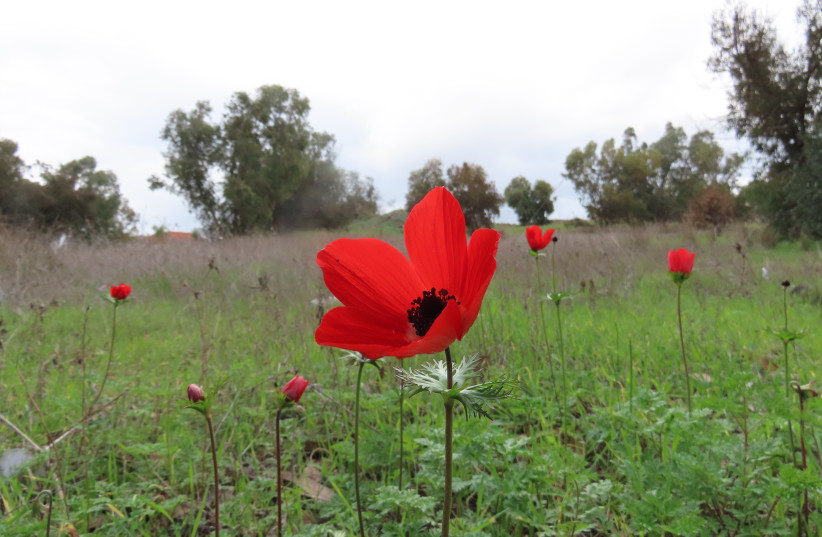The first red anemones of the season were seen blooming this week in the Negev’s Eshkol National Park. Their vibrant red hue bursting from the soil created a stark contrast against the charred landscape that had been blackened by murder and fire just three months prior.
The flowers were documented by the Society for the Protection of Nature in Israel (SPNI).
"One of the most exciting things is to see the renewal of nature in the location of one of the largest disasters that the State of Israel has experienced," said SPNI CEO Dan Alon. "Nature may not be able to fix what happened, but it can help in healing and recovery."
Anemones, known as “kalaniyot” in Hebrew, blossom in the winter, explained SPNI’s Amir Balaban. Blue and white anemones have already begun to grow in the northern region. However, the peak of the flowering season is from the end of January until mid-February, when a vast expanse of the country, particularly the South, will be adorned with a vibrant red carpet.
According to SPNI, surveys have shown that anemones are the most cherished flower in Israel. In the mid-20th century, anemone populations in Israel declined because too many people picked them. An SPNI campaign encouraging people to “look but don’t touch,” along with educational initiatives, legislative measures, and enforcement, played a pivotal role in their resurgence.

First known casualty of Oct 7 massacre helped popularize the flower
"The anemone is a perennial flower with a small bulb hidden in the ground," Balaban added. "The flower attracts pollinators, including bees, that collect pollen and mate, spreading the next generation."
The flowers became especially popular with the launch of the Darom Adom (Red South) festival, founded by Ofir and Vered Libstein in 2007. Ofir Libstein, head of the Sha'ar Hanegev Regional Council, was the first known victim of the October 7 massacre. He and his son, 19-year-old Nitzan Libstein, were murdered defending Kibbutz Kfar Aza, where they lived.
Until now, the Darom Adom festival has been held each year from mid-January until the end of February and welcomed visitors from across Israel. The festival included enjoying the red flowers, arts and crafts, and live performances. This year, there will be no festival.
A picture of Libstein on his Facebook page shows him lying in a field of red anemones, his hand behind his head, smiling.
Just two days before the Hamas rampage, Libstein hosted a group of 700 Christian Zionists in the Negev and along the Gaza border fence to dedicate the “Christian Embassy Nature Park” land that had been rehabilitated through Christian gifts in partnership with Keren Kayemeth LeIsrael-Jewish National Fund. The Christians had chosen to rehabilitate a section of Be’eri Forest that had been burned over recent years by Gaza arsonists launching fire kites and balloons from Gaza.
On October 7, the park was trampled by terrorists and then by the IDF and its tanks as it rushed to defend Israel.
Solidarity from International Christian Embassy in Jerusalem
International Christian Embassy in Jerusalem Vice President and Senior Spokesman David Parsons said that Christians worldwide hope to plant 1,200 vibrant red tulips in the area in remembrance of the 1,200 lives lost to Hamas as soon as they can go back to the area.
"This year, in the south, extensive flowering areas were affected due to the war, and we hope that part of the future restoration will also involve nature and the environment in full cooperation with the communities," Balaban said.
Seeing the first anemones "is a special and emotional sight that raises thoughts about the future," added Alon. "The rain and the renewed nature give a sense of hope.
"We all grieve for and mourn the incomprehensible deaths of the victims, worry about the well-being of the kidnapped, pray for the quick recovery of the injured, and hope for the return of our soldiers," he continued. "We also wish the residents [of the South] to return and rebuild their lives and for Israeli tourists to be able to return and travel in peace and security."
